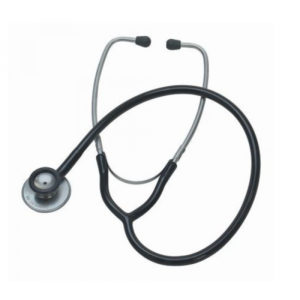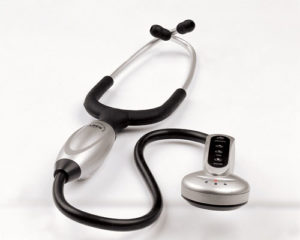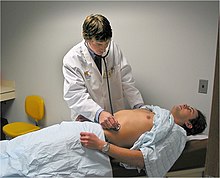گوشی پزشکی (استتوسکوپ)
استتوسکوپ (stethoscope) یا گوشی پزشکی از دو کلمه Stetho به معنی سینه وscope به معنی نمایش یا نشان دادن، تشکیل یافته و در کل به معنی وسیله ای برای شنیدن است.
استتوسکوپ یا گوشی پزشکی دستگاهی است که با هدف تشخیص صداهای داخلی بدن بکار می رود.این دستگاه معمولا جهت شنیدن صدای
قلب و یا ریه بکار گرفته شده و به منظور گوش دادن به صدای روده ها و جریان خون شریانی و وریدی نیز کاربرد دارد.با بکارگیری گوشی
پزشکی در کنار دستگاه فشارسنج می توان از طریق تشخیص صدای جریان خون،فشار سیستولیک و دیاستولیک را تعیین نمود.
اجزای گوشی پزشکی
گوشی پزشکی سه قسمت اصلی دارد. قسمت اول گوشی روی بدن فرد قرار میگیرد و پرده دیافراگم یا قسمت زنگولهای آن ارتعاشات بدن
را تبدیل به ارتعاشات صوتی کرده و کمی تشدید مینماید. سپس صوت حاصل وارد لوله یا لولههای هدایتکننده صدا شده و در نهایت از طریق گوشیهای مخصوصی وارد گوش پزشک میگردد.
گوشیهای پزشکی انواع گوناگونی دارند. قسمت دیافراگمی گوشی (که سطح بیشتری دارد) به صورت معمول برای گوش دادن صداهای
مختلف بدن به کار میرود.قسمت زنگولهای (به نام bell) که عملاً پردهای ندارد فقط در مواردی به کار میرود که صدای آن اندام از بمی خاصی
برخوردار است و باید با استفاده از قسمت زنگولهای این کیفیت را تشدید کرد.
کاربرد گوشی پزشکی
بیشترین ارزش تشخیصی گوشی پزشکی ، شنیدن صداهای قلب در ناهنجاری های مادرزادی ، مشکلات دریجه ای قلب ،بی نظمی ها و
نارسایی قلب می باشد و در مراحل حاد سکته قلبی ممکن است تغییر خاصی در صداهای قلبی ایجاد نشود.
انواع گوشی های پزشکی

گوشی پزشکی آکوستیکی

گوشی پزشکی الکترونیکی

گوشی پزشکی جنین
Current practice
Stethoscopes are often considered as a symbol of healthcare professionals, as various healthcare providers are often seen or
depicted with stethoscopes hanging around their necks.
A 2012 research paper claimed that the stethoscope, when compared to other medical equipment, had the highest positive
impact on the perceived trustworthiness of the practitioner seen with it.
The advent of practical, widespread portable ultrasonography (point-of-care ultrasonography) in the late 1990s to early 2000s
led some physicians to ask how soon it would be before stethoscopes would become obsolete.
Others answered that they thought the relationship of the various tools (stethoscopes and digital devices) would change but
that it would be a long time before stethoscopes were obsolete.
A decade later, in 2016, the same two sides of the coin were still recognized. One cardiologist said, “the stethoscope is dead”, but
a pediatrician said, “We are not at the place, and probably won’t be for a very long time” where stethoscopes were obsolete.
One consideration is that it depends on the segment of health care (emergency medical services, nursing, medicine) and the
specialty. “Stethoscopes retain their value for listening to lungs and bowels for clues of disease, experts agree.
Types
Acoustic stethoscopes are familiar to most people, and operate on the transmission of sound from the chest piece, via air-filled
hollow tubes, to the listener’s ears. The chestpiece usually consists of two sides that can be placed against the patient for sensing
sound: a diaphragm (plastic disc) or bell (hollow cup).
If the diaphragm is placed on the patient, body sounds vibrate the diaphragm, creating acoustic pressure waves which travel up
the tubing to the listener’s ears. If the bell is placed on the patient, the vibrations of the skin directly produce acoustic pressure
waves traveling up to the listener’s ears.
The bell transmits low frequency sounds, while the diaphragm transmits higher frequency sounds. To deliver the acoustic energy
primarily to either the bell or diaphragm, the tube connecting into the chamber between bell and diaphragm is open on only one side and can rotate.
The opening is visible when connected into the bell. Rotating the tube 180 degrees in the head connects it to the diaphragm.
This two-sided stethoscope was invented by Rappaport and Sprague in the early part of the 20th century.
Electronic
An electronic stethoscope (or stethophone) overcomes the low sound levels by electronically amplifying body sounds. However,
amplification of stethoscope contact artifacts, and component cutoffs (frequency response thresholds of electronic stethoscope
microphones, pre-amps, amps, and speakers) limit electronically amplified stethoscopes’ overall utility by amplifying mid-range
sounds, while simultaneously attenuating high- and low- frequency range sounds.
Currently, a number of companies offer electronic stethoscopes. Electronic stethoscopes require conversion of acoustic sound
waves to electrical signals which can then be amplified and processed for optimal listening. Unlike acoustic stethoscopes, which are
all based on the same physics, transducers in electronic stethoscopes vary widely.
Recording
Some electronic stethoscopes feature direct audio output that can be used with an external recording device, such as a laptop or MP3 recorder.
The same connection can be used to listen to the previously recorded auscultation through the stethoscope headphones,
allowing for more detailed study for general research as well as evaluation and consultation regarding a particular patient’s
condition and telemedicine, or remote diagnosis.There are some smartphone apps that can use the phone as a stethoscope.
Doppler
A Doppler stethoscope is an electronic device that measures the Doppler effect of ultrasound waves reflected from organs within
the body. Motion is detected by the change in frequency, due to the Doppler effect, of the reflected waves.
Hence the Doppler stethoscope is particularly suited to deal with moving objects such as a beating heart.It was recently
demonstrated that continuous Doppler enables the auscultation of valvular movements and blood flow sounds that are
undetected during cardiac examination with a stethoscope in adults.
The Doppler auscultation presented a sensitivity of 84% for the detection of aortic regurgitations while classic stethoscope
auscultation presented a sensitivity of 58%. Moreover, Doppler auscultation was superior in the detection of impaired ventricular relaxation.
Since the physics of Doppler auscultation and classic auscultation are different, it has been suggested that both methods could complement each othe
History
The stethoscope was invented in France in 1816 by René Laennec at the Necker-Enfants Malades Hospital in Paris. It consisted of
a wooden tube and was monaural. Laennec invented the stethoscope because he was not comfortable placing his ear directly onto a woman’s chest to listen to her heart.
He observed that a rolled piece of paper, placed between the patient’s chest and his ear, could amplify heart sounds without
requiring physical contact. Laennec’s device was similar to the common ear trumpet, a historical form of hearing aid; indeed, his
invention was almost indistinguishable in structure and function from the trumpet, which was commonly called a “microphone”.
Laennec called his device the “stethoscope

